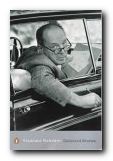a critical examination of Nabokov’s collected stories
 In ‘Christmas’ (December 1925) Nabokov returns to a more traditional narrative mode to record one of the many evocations of his Russian childhood which grace the edges of his fiction. The setting is an accurate picture of the type of aristocratic country estate on which Nabokov had lived as a child (and inherited at the age of seventeen). It is enveloped in midwinter snow, and is presented complete with master (Sleptsov) and servant (Ivan) who might have strayed over from works by Chekhov or Tolstoy.
In ‘Christmas’ (December 1925) Nabokov returns to a more traditional narrative mode to record one of the many evocations of his Russian childhood which grace the edges of his fiction. The setting is an accurate picture of the type of aristocratic country estate on which Nabokov had lived as a child (and inherited at the age of seventeen). It is enveloped in midwinter snow, and is presented complete with master (Sleptsov) and servant (Ivan) who might have strayed over from works by Chekhov or Tolstoy.
Sleptsov has returned to his estate to bury his recently deceased teenage son in the family vault of the village church. He is suffering under the burden of an almost insupportable grief and sense of loss. Wandering about his estate, he pictures his son in midsummer, collecting butterflies. He then assembles some of his son’s effects, and on reading fragments of a diary recording the boy’s youthful infatuation for a local girl (of which he was not aware) he feels that he will die from grief by the next day. But just then a chrysalis from the boy’s collection bursts open in the warmth of the room and a large moth emerges, opens its wings, and takes a ‘full breath under the impulse of tender, ravishing, almost human happiness’ (DS,p.161).
The use of symbols here is conventional, but they are neatly deployed. Rather unusually for Nabokov, but in keeping with the social beliefs of a pre-Revolutionary Russia, they include Christian symbols. The story is set in the deepest part of the winter, at the turning point of the year, as a parallel to the depth of Sleptsov’s grief. Crucifixes appear on the church and on a Christmas tree which Sleptsov wants taken away but which is retained by the faithful servant – holding on to traditions in very much the same manner as a servant in ‘Master and Man’ or Anna Karenina. And the events of the narrative reach their quiet climax on Christmas Eve, with the chrysalis, which was thought to be dead, acting as a symbol of resurrection – the rebirth of life and of Sleptsov’s will to live.
Even though they are conventional, Nabokov shows delicacy and restraint in handling these symbols, just as he cleverly relates them to his theme and brings them into harmony with the structure of the story. At the climax of the story Sleptsov is reading his son’s diary, which forms a living link between them: it turns out to be concerned with butterflies (the symbol of life in the story) and the boy’s own sense of loss and separation from the girl he will never see again, following the end of a youthful romance the ignorance of which has separated his father from him. Artistically too, the chrysalis acts as a symbol of a supposedly dead past being brought back to life in the present.
For that is the sub-text of the story – Nabokov’s attempt to record a past, his own personal experience of life in a pre-Revolutionary Russia to which he knows he can never return. He grieves for the loss of his own country and culture, but he can bring it back to life by an act of memory and artistic creation. It is for this reason that his autobiography bears the title Speak, Memory.
The story uses as some of its material a youthful love affair from Nabokov’s own life, but it is not difficult to see Nabokov fictionalising his adult self as Sleptsov and his youthful self as the butterfly collecting son which he actually was in the years before the revolution. This is one response to the pain of irreversible exile – a meticulous and sensitive recollection of the past – and Nabokov was to make frequent use of this device in that part of his writing which seeks to record elements of his personal biography. But in his fiction he more frequently asserted his enthusiasm for life by a recording of the present, even when it was being experienced in Germany – as his next story shows.
© Roy Johnson 2005
![]() Vladimir Nabokov: The Collected Stories – Amazon UK
Vladimir Nabokov: The Collected Stories – Amazon UK
![]() Vladimir Nabokov: The Collected Stories – Amazon US
Vladimir Nabokov: The Collected Stories – Amazon US
Vladimir Nabokov web links
Vladimir Nabokov greatest works
Vladimir Nabokov criticism
Vladimir Nabokov life and works